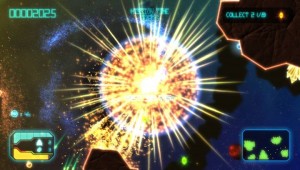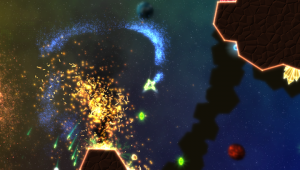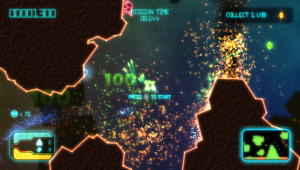Liverpool Sound and Vision Rating * * * * *
Gravity Crash Ultra is a twin-stick shooter game available for download from the PlayStation Store for the PS Vita. The game is an enhanced port of the PS3 game Gravity Crash, which was released in November 2009 and for the PSP in July 2010.
There is a pilot training feature that is recommended to be undertaken before the player heads into the levels as it will teach them the gameplay elements of the game step by step in preparation. The campaign mode is comprised of five systems with each system containing six planets resulting in a total of thirty levels with each culminating in a planet containing a battle, whilst the player can replay any planet they have completed in the planet mode. Every system has a secret one, which is unlocked when you have found the five artefacts spread across the six planets in that particular system, which increases the total amount of planets from thirty to thirty-five; providing the player can find the required number of artefacts per system.
There is always a mission objective, such as destroying a certain amount of a particular enemy type or collecting a number of a particular type of coloured gem, which results in the player successfully opening the wormhole to enter and complete the level, although there is the choice to continue exploring the level in order to destroy more opponents and enemy infrastructure, finding more gems to collect or attempting to rescue more crewmen. There are also artefacts hidden around each of the planets with one artefact to collect per planet, while there are green nodes that are hidden across each planet that will provide players with a points bonus upon completing the planet, which are positive design choices as they both encourage exploration of every tiny detail throughout each level. Points can be scored by destroying enemies with more points awarded for obliterating larger foes, while destroying enemy infrastructures such as satellites also provide points, alongside collecting various colours of gems, which is a great design choice as it makes you want to explore more of the level in an attempt to accumulate a more competitive score.
The level design has plenty of variation in regards to the layout of the landscape and progressively introduces new elements, such as lava that will rise to block an area after a particular amount of time has elapsed and underwater sections, amongst other changes to the surrounding environments. There are secret areas in certain levels that require persistent fire to split the rock of the inner surface, which usually reveals a hidden gem, power-up, artefact or node.
 There is a pretty good variation of the enemy design as there are gun and missile turrets that are fixed to the surface of the planet as are missile launchers that will fire from a ground surface of the planet that you will have to attempt to evade and shoot down; astronauts who are walking along the surface of the planet and others who are flying and firing at your ship; creatures that are reminiscent of smaller and larger octopuses that you will have to evade their random movements and destroy; mines that will explode if your ship hits them; lava that will erupt and potentially rise forcing you to move upwards to take evasive action; and even incoming meteor showers that will all be attempting to destroy your ship, amongst many more enemies.
There is a pretty good variation of the enemy design as there are gun and missile turrets that are fixed to the surface of the planet as are missile launchers that will fire from a ground surface of the planet that you will have to attempt to evade and shoot down; astronauts who are walking along the surface of the planet and others who are flying and firing at your ship; creatures that are reminiscent of smaller and larger octopuses that you will have to evade their random movements and destroy; mines that will explode if your ship hits them; lava that will erupt and potentially rise forcing you to move upwards to take evasive action; and even incoming meteor showers that will all be attempting to destroy your ship, amongst many more enemies.
The level editor allows you to create your own degree of difficulty and test yourself with levels that are as easy or as challenging as you want them to be. This feature really adds a lot of further gameplay to Gravity Crash Ultra and makes the creative possibilities limitless. The level editor becomes even more exciting by going to a place that is rarely ever ventured and that is by allowing levels to be uploaded to the internet to have your creativity shared with players from around the world! The user created levels are shared between the PS3 and Vita versions of the game, which effectively provides five years worth of user created levels for the player to enjoy and explore any time you choose to do so from the PS3 version, whilst new levels created within the Vita version are also accessible from the PS3 version.
The control scheme is supremely easy to master as it is purely mapped to the analogue sticks with three variations in how the analogue sticks manage the manoeuvring of the ship. The control schemes are as simple to control as changing the direction of the left analogue stick to manoeuvre the ship and changing the direction of the right analogue stick to shoot, while pressing R will fire your special weapon and pressing start to display the pause menu.
The graphics are a throwback to retro gaming whilst bringing that retro look into the present as there are so many particle effects when you destroy an enemy or part of the enemy infrastructure or do pretty much anything with a permanent explosion of colour hitting the screen in glorious Vita native resolution graphics and all at an exceptional level of performance at 60 frames per second. Even better yet is the attention to detail that has been invested in improving the graphics across the board in comparison to the PS3 version with enhanced graphical effects including lighting and particle systems.
The presentation of the game is solid with a great touch screen based user interface across various menus such as the main, level editor, online leaderboards, manual, audio settings and gameplay menus with support for navigation via the left analogue stick, directional pad and face buttons, although it does not include support for navigation via the right analogue stick and rear touch pad, although that is not an issue considering the other methods of navigation that are available. The background of the menu screens revolves around the orbit of planets, suns and moons amongst the glistening of the stars and shooting stars in outer space, while not pressing anything during the main menu will produce a gameplay demonstration with a brief glimpse of what you can anticipate from Gravity Crash Ultra.
The audio consists of voice-overs and music with the sound effects including plenty of weapons being fired from your ship at enemies and them firing back at your ship with loud explosions as well as incidental sound effects, such as a sound for when a crewman has been successfully rescued, an alarm for when the ship is about to run out of fuel, another sound for when extracting fuel from fossils and a sound for when fuel has been collected, while the voice-overs announce when you have collected a power-up. The music is provided by Tim Wright who players may know under the name CoLD SToRAGE as he has an extensive discography of soundtracks he has composed for very popular games since the era of the Amiga starting in 1989 with Puggs in Space and continuing through various Lemmings games from 1990 onwards, alongside Shadow of the Beast 2 and 3, amongst many more.
 However, Tim Wright is probably best known for his compositions on such classic videogames as WipEout in 1995, Formula 1 and WipEout 2097 both in 1996, Life Force: Tenka and Colony Wars both in 1997 on PS1 with WipEout Pure on PSP in 2005 and more games in recent years, such as Sonic & Sega All-Stars Racing on PS3 in 2010, Travel Bug on PS Vita in 2012, Velocity on PlayStation Mobile in 2012 and Table Top Racing on PS Vita in 2014. It must be said that the soundtrack nicely ties all of the audio together in an electronic form of dance music that is every bit as good as Tim Wright’s classic videogame soundtracks.
However, Tim Wright is probably best known for his compositions on such classic videogames as WipEout in 1995, Formula 1 and WipEout 2097 both in 1996, Life Force: Tenka and Colony Wars both in 1997 on PS1 with WipEout Pure on PSP in 2005 and more games in recent years, such as Sonic & Sega All-Stars Racing on PS3 in 2010, Travel Bug on PS Vita in 2012, Velocity on PlayStation Mobile in 2012 and Table Top Racing on PS Vita in 2014. It must be said that the soundtrack nicely ties all of the audio together in an electronic form of dance music that is every bit as good as Tim Wright’s classic videogame soundtracks.
The trophy list includes twenty trophies with nineteen bronze and one silver trophy. There are some trophies that are earned as natural progression through the game allows, such as the Guidance Software Approved bronze trophy for completing all of the training missions; the Obsolete Technology bronze trophy for defeating any boss; and the 8 Bits of Destruction bronze trophy for destroying 255 guns or missile turrets. There are a couple of online trophies including the System Analyst bronze trophy for finding five user created levels you like and rate the creators, which is certainly the easier of the two, while the harder of the two has to be the I Made This bronze trophy for creating and publishing a level with the hardest part having to be the requirement for it to be rated by five users, although the level itself can be as basic as you want to make it. The harder trophies include the Hyperlink bronze trophy for activating all 35 of the nodes across all 35 planets including the five secret planets; the 00101010 bronze trophy for collecting all 25 of the artefacts; the Cache Hit bronze trophy for finding all of the hundreds of gems scattered across all of the 35 planets including the five secret planets that are unlocked when you have collected all 25 of the artefacts; the Feeble Humans bronze trophy for rescuing 50 of the 55 stranded crewmen as the landing surface and landing approach is a little tricky on occasion for areas of certain planets; and the End-Of-File silver trophy for completing the campaign mode across each of the five planets, boss and secret planet for each of the five systems, while the hardest trophy of all being the Mega Points bronze trophy for earning a score of 1,048,576 points. It should be estimated depending upon skill, a good trophy guide to provide some helpful tips and that it would take between fifteen to twenty hours to 100% the trophy list.
There are no difficulty levels, although the complexity naturally increases for each planet as the requirements to perfect your performance in a level; results in having to rescue more crewmen, collect more gems and destroying more enemies, which provides more of a challenge through an appropriate difficulty curve that is tough in certain areas, but never to an extent that the player wants to stop playing the game as the balancing of the difficulty curve is always spot on. It must be said that the overall difficulty level has been reduced in comparison to the original PS3 release, especially given the introduction of a new anti-grav ship that is easier to fly and land on surfaces to rescue crewmen as well as a clearer and more detailed radar that makes it easier to see what is around and ahead of your position.
There is no form of local or online multiplayer in regards to a co-operative or competitive format, although the chances of this are reduced by it being on the Vita in comparison to the possibility of split-screen local multiplayer on some PS3 or PS4 games. However it could be possible to imagine a pass the Vita form of local multiplayer in which a player passes the Vita to another player after the first player’s ship has been destroyed, resulting in the start of the second player’s turn and so on with the potential of each player having their own score to provide a form of competitiveness to see which player leads their friends in the local high scores, while playing co-operatively in an attempt to reach the end of the planet. It could also imagined that the implementation of online co-operative multiplayer, although the difficulty may have had to be adjusted to not become too easy with two players, while another idea could have been for a form of competitive online multiplayer as one player controls the ship on the good side attempting to rescue crewmen, while destroying the villains and their infrastructure and the other player is controlling the villains and their infrastructure in an attempt to destroy the good guy, while preserving their infrastructures.
The online leaderboards focuses on global rankings, your friends and the players personal score, whilst also covering seventy-one separate categories including the high scores for the campaign mode, alongside the high scores provided from the planet mode and the best times provided from the campaign mode for completing each of the thirty planets and five secret planets with each leaderboard containing each player’s rank; name (PSN ID); and high score or best time with the positioning of each player based upon the scores or times for completing each planet depending upon the category being viewed.
 The replayability of Gravity Crash Ultra stems from many directions, such as having the ability to make the use of choice of simply attempting the mission objective or continuing your exploration of the planet to destroy all of the enemies and enemy infrastructures, collecting gems and artefacts and rescuing crewmen, while earning points from succeeding in those areas which mount up in the attempt for a higher score for your highest possible positioning amongst the competitive online leaderboards, then playing through all of the planets again to attempt to complete the levels as quickly as possible to post your best time for each planet to the online leaderboards. The flow of the gameplay breeds even more replay value as the campaign mode posts the best times for each planet which has been completed to the online leaderboards, while making sure not to post the high score, which results in having to replay all of the planets in the said mode in order to post the high score to the online leaderboards. However, the largest area of replay value has to come in the form of the level editor, which allows the originality to create own planets and share those levels with the entire world, download levels that other players from the world over have created and vote for their creations too, therefore rather cleverly creating an endless amount of replayability.
The replayability of Gravity Crash Ultra stems from many directions, such as having the ability to make the use of choice of simply attempting the mission objective or continuing your exploration of the planet to destroy all of the enemies and enemy infrastructures, collecting gems and artefacts and rescuing crewmen, while earning points from succeeding in those areas which mount up in the attempt for a higher score for your highest possible positioning amongst the competitive online leaderboards, then playing through all of the planets again to attempt to complete the levels as quickly as possible to post your best time for each planet to the online leaderboards. The flow of the gameplay breeds even more replay value as the campaign mode posts the best times for each planet which has been completed to the online leaderboards, while making sure not to post the high score, which results in having to replay all of the planets in the said mode in order to post the high score to the online leaderboards. However, the largest area of replay value has to come in the form of the level editor, which allows the originality to create own planets and share those levels with the entire world, download levels that other players from the world over have created and vote for their creations too, therefore rather cleverly creating an endless amount of replayability.
Overall, when the original Gravity Crash released in 2009 on PS3; players believed it was so good that it would never be improved upon, but Gravity Crash Ultra actually far surpasses the original by attempting to improve upon every area of the game and completely succeeding in doing so! Gravity Crash Ultra is an absolute must purchase that gamers will not be able to put down, especially considering the unlimited replay value from the exceptional level editor and all at the amazing price of only £5.79!
Jason Bonnar
Analysis
- Title: Gravity Crash Ultra
- Developer: Just Add Water
- Publisher: Just Add Water
- System: PS Vita
- Format: PSN Download
- Cross-Buy: No
- Cross-Play: No
- Players: 1 (Online Leaderboards/User Created Content Sharing)
- Memory Card Space Required: 97MB (Version 1.01)